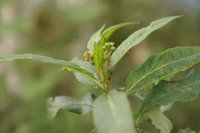
Aphis nerii are a recurring theme on asclepias tuberosa. On what seems to be a more or less regular schedule, the beginnings of a new oleander aphid colony will appear on the tender growing tip of a milkweed stem. The colony blossoms in a day or two to cover the tenderest growth.
In this case, there are no predator species evident, and no mummified aphids to indicate the activity of predator wasps. But the colony starts to diminish, as in this photo taken the following day:

Further down the milkweed plant, new colonies are gathering or forming at the leaf joints. But in a few days, those colonies alsoo dwindle and today, ten days after the aphids first appeared there is little evidence of their existence on the budding milkweed. I recorded aphis nerii colonies on the same milkwe
 ed plant, all appearing and quickly disappearing, in late August, early September, early October and late November of 2005. There was some predation by syrphids (Sept) and wasps (Oct). Aphids are said to be stimulated by overcrowding or environmental conditions (like temperature or day length) to migrate to new food sources by developing a winged generation which flies away. So, winged aphis nerii mush visit periodically to restart the colonies, though I haven't ever seen winged individuals on this particular milkweed plant. But I've seen them walking.
ed plant, all appearing and quickly disappearing, in late August, early September, early October and late November of 2005. There was some predation by syrphids (Sept) and wasps (Oct). Aphids are said to be stimulated by overcrowding or environmental conditions (like temperature or day length) to migrate to new food sources by developing a winged generation which flies away. So, winged aphis nerii mush visit periodically to restart the colonies, though I haven't ever seen winged individuals on this particular milkweed plant. But I've seen them walking. This aphid was traveling down a
 salvia clevelandii stem. It was moving at a pretty fast pace for an aphid, I think. To go walking, an aphid must disengage its sucking mouthparts from the plant. There is some risk of damaging the mouthparts in this process so one could suppose the aphid would only go walking if it was really worthwhile. The one reference to aphids walking in all the wide internet said they do it to get away from danger or if the host plant dies. I saw no sign of predators among this colony of walking aphids. You can see the milkweed is not in great condition but not so bad either. So?
salvia clevelandii stem. It was moving at a pretty fast pace for an aphid, I think. To go walking, an aphid must disengage its sucking mouthparts from the plant. There is some risk of damaging the mouthparts in this process so one could suppose the aphid would only go walking if it was really worthwhile. The one reference to aphids walking in all the wide internet said they do it to get away from danger or if the host plant dies. I saw no sign of predators among this colony of walking aphids. You can see the milkweed is not in great condition but not so bad either. So? Is it possible the milky sap of the milkweed begins to gum up the feeding holes of the aphids after a time, and they walk to nearby fresh leaves to get a meal? But why do the walking ones seem intent, while walking, on exploring the nearby salvia clevelandii stems when they don't feed on that plant? Do aphids really have time, in their abbreviated lives, to stroll?
Is it possible the milky sap of the milkweed begins to gum up the feeding holes of the aphids after a time, and they walk to nearby fresh leaves to get a meal? But why do the walking ones seem intent, while walking, on exploring the nearby salvia clevelandii stems when they don't feed on that plant? Do aphids really have time, in their abbreviated lives, to stroll?
No comments:
Post a Comment